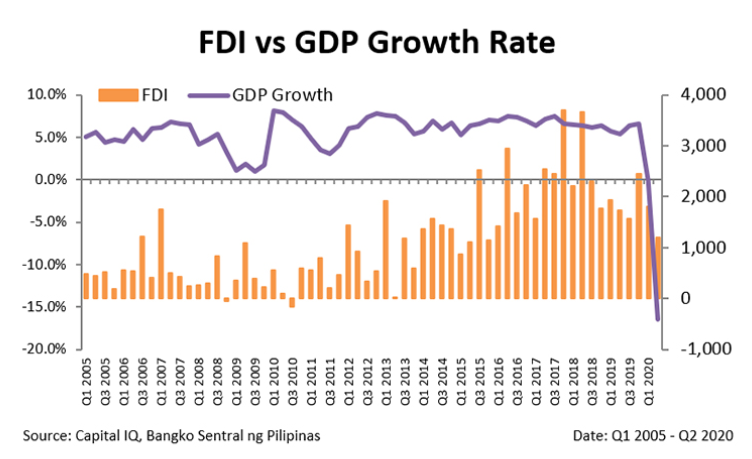MONDAY MACRO: At $481 million in June, this economic indicator is 30% lower than last year, but long-term prospects still remain positive

This economic indicator helps investors gauge a country’s growth potential, acting as another vital source of capital for a country’s economic progress. It is especially important for a developing country like the Philippines.
Before COVID-19, the Philippine government expected this metric to reach higher levels, given the more attractive economic policies in place. With all that’s happened recently in the Philippines and in the world, this indicator has understandably come down from recent highs.
Philippine Markets Daily:
The Monday Macro Report
Powered by Valens Research
In our February 24th Monday Macro report, we talked about how analysts were expecting that Foreign Direct Investments (FDI) in 2020 would improve given looser government policies such as the lifting of foreign ownership limitation and lower corporate income tax.
To recap, FDI refers to a controlling ownership of a foreign entity in a business operating in a country.
An increase in the Philippines’ FDI would not only bring financial capital to the developing country but also the skills and knowledge of these foreign investors. Moreover, this type of investment requires a long holding period for these investors to realize a positive return on their invested capital (ROIC).
Because of the time period of these investments and the skills and knowledge that the investors can contribute, FDI can lead to sustainable economic development.
However, even with more attractive policies such as relaxed foreign ownership requirements for small and medium-sized enterprises (SMEs) and the gradual lowering of corporate income tax to 20%, the Philippines is unlikely to see higher FDI levels this year.
FDI preliminary results for the month of June was at $481 million, amounting to a total of $1,197 million net inflows for the second quarter or a 30% decline from the same period last year.
Key variables for the depressed FDI levels were the counteractions against COVID-19 and the strengthening of the Philippine Peso.
Initially, the country’s stable currency created an environment that would lead to higher FDIs. However, with the Peso now stronger and having appreciated by roughly 5% year-to-date, it has become more expensive to invest in the country than in 2019.
The chart below shows FDI with GDP growth, where historical peaks and troughs of the FDI mirror that of the GDP growth rate.
While the Philippines’ GDP growth rate has remained stable at an average of 5.6% in the last ten quarters pre-pandemic, FDI has seen more volatility. FDI reached a high of $3,699 million in Q4 2017, and has been on a general downward trend ever since. That was also the year when FDI as a percentage of GDP peaked at 3.12% from its previous high of 3.17% in 1998.

The decline in FDI levels is not something to be too concerned about at present, especially during a pandemic that has plagued the global economy for the past six months.
The lower FDI levels also come at a time when the US and China, both major trading partners of the Philippines, remain in a trade war that began in 2018. With no signs of the war ending soon, muted investor concerns will likely continue to curb foreign direct investments in the Philippines.
It is important to note that while an increase in FDI would contribute to improved GDP levels, it is not the driving factor for the Philippines’ post-pandemic economic recovery.
Despite the near-term headwinds from the pandemic, Uniform Accounting still points to overall Philippine corporate profitability remaining at average levels. Since this was not a credit-driven recession, companies still have healthy balance sheets to help them survive this pandemic and then grow after. Uniform earnings is expected to decline by 25% in 2020, before making its way to a full recovery the following year.

When the pandemic ends and the global economy recovers, it is likely that the Philippines will benefit from increased investments that are to be expected from the more investor-friendly policies in the country.
About the Philippine Market Daily
“The Monday Macro Report”
When just about anyone can post just about anything online, it gets increasingly difficult for an individual investor to sift through the plethora of information available.
Investors need a tool that will help them cut through any biased or misleading information and dive straight into reliable and useful data.
Every Monday, we publish an interesting chart on the Philippine economy and stock market. We highlight data that investors would normally look at, but through the lens of Uniform Accounting, a powerful tool that gets investors closer to understanding the economic reality of firms.
Understanding what kind of market we are in, what leading indicators we should be looking at, and what market expectations are, will make investing a less monumental task than finding a needle in a haystack.
Hope you’ve found this week’s macro chart interesting and insightful.
Stay tuned for next week’s Monday Macro report!
Regards,
Angelica Lim
Research Director
Philippine Markets Daily
Powered by Valens Research
www.valens-research.com




